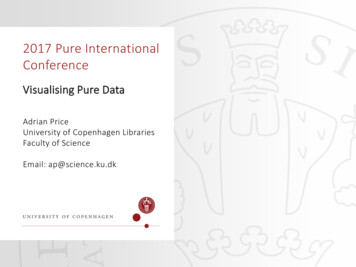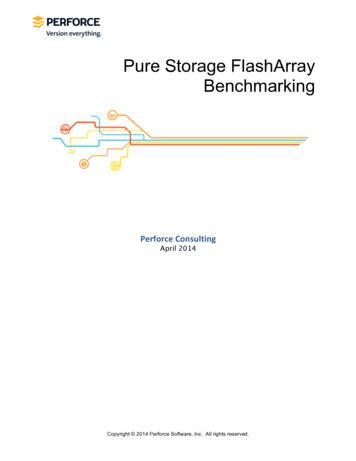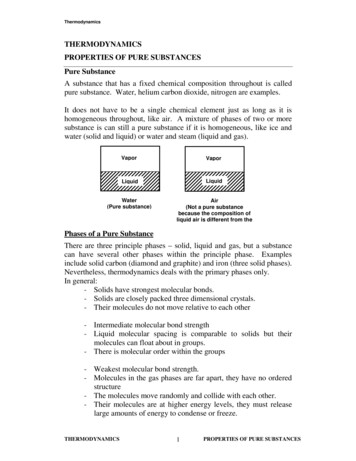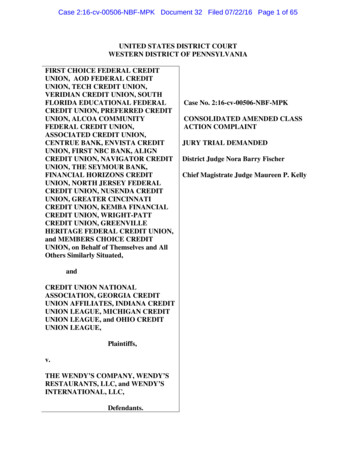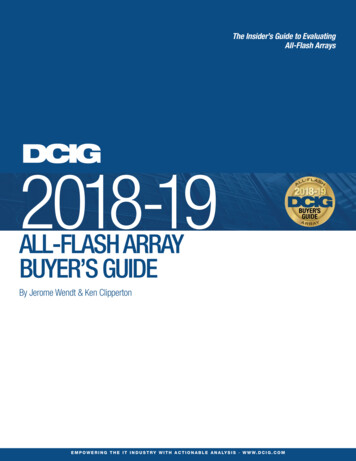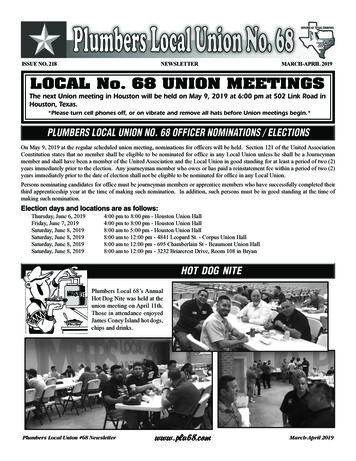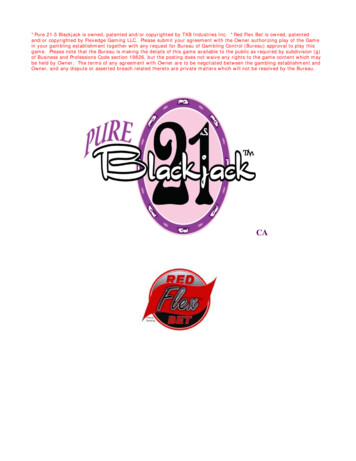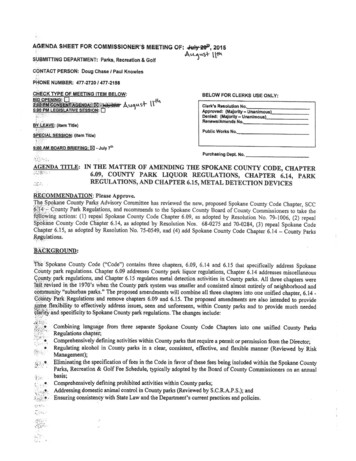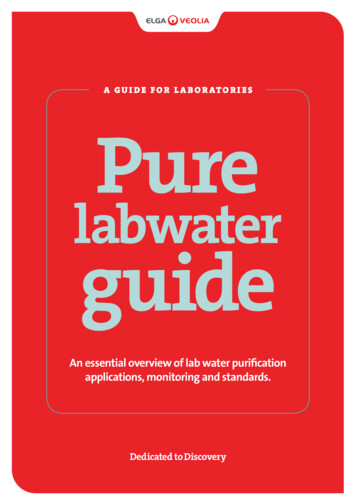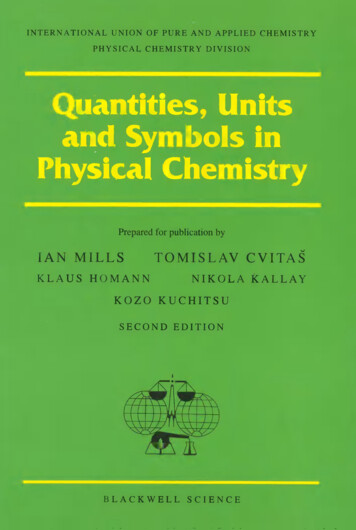
Transcription
INTERNATIONAL UNION OF PURE AND APPLIED CHEMISTRYPHYSICAL CHEMISTRY DIVISION-IIQuintitie, Ilnitsand Symbols in:1'hysical ChemistryPrepared for publication byIAN MILLSKLAUS HOMANNTOMISLAV CVITANIKOLA KALLAYKOZO KUCHITSUSECOND EDITIONBLACKWELL SCIENCEji
Quantities, Units and Symbolsin Physical Chemistry
INTERNATIONAL UNION OF PURE AND APPLIED CHEMISTRYPHYSICAL CHEMISTRY DIVISIONCOMMISSION ON PHYSICOCHEMICAL SYMBOLS,TERMINOLOGY AND UNITSIUPAC
INTERNATIONAL UNION OF PURE AND APPLIED CHEMISTRYQuantities, Units andSymbols in Physical ChemistryPreparedfor publication byIAN MILLSTOMISLAV CVITAReadingZagrebKLAUS HOMANNNIKOLA KALLAYDarmstadtZagrebKOZO KUCHITSUTokyoSECOND EDITIONbBlackwellScience
1993 International Union of Pure andApplied Chemistry and published for them byBlackwell Science LtdEditorial Offices:Osney Mead, Oxford 0X2 OEL25 John Street, London WC1N 2BL23 Ainslie Place, Edinburgh EH3 6AJ350 Main Street, MaIdenMA 02148 5018, USA54 University Street, CantonVictoria 3053, Australia10, rue Casimir Delavigne75006 Paris, FranceOther Editorial Offices:Blackwell Wissenschafts-Verlag GmbHKurfUrstendamm 5710707 Berlin, GermanyBlackwell Science KKMG Kodenmacho Building7—10 Kodenmacho NihombashiChuo-ku, Tokyo 104, JapanThe right of the Author to beidentified as the Author of this Workhas been asserted in accordancewith the Copyright, Designs andPatents Act 1988.All rights reserved. No part ofthis publication may be reproduced,stored in a retrieval system, ortransmitted, in any form or by anymeans, electronic, mechanical,photocopying, recording or otherwise,except as permitted by the UKCopyright, Designs and Patents Act1988, without the prior permissionof the copyright owner.First published 1988Reprinted 1988Reprinted as paperback 1989Russian translation 1988Hungarian translation 1990Indian reprint edition 1990Japanese translation 1991Second edition 1993Reprinted 1995, 1996, 1998DISTRIBUTORSMarston Book Services LtdP0 Box 269AbingdonOxon 0X14 4YN(Orders: Tel: 01235 465500Fax: 01235 465555)USA and CanadaCRC Press, Inc.2000 Corporate Blvd, NWBoca RatonFlorida 33431AustraliaBlackwell Science Pty Ltd54 University StreetCarlton, Victoria 3053(Orders: Tel: 3 9347 0300Fax:3 9347 5001)A catalogue record for this titleisavailable from the British LibraryISBN 0-632-03583-8Library of CongressCataloging in Publication DataQuantities, units and symbols in physical chemistry!prepared for publication byIan Mills. [ct al.}.—2nd ed.cm.p.At head of title: International Unionof Pure and Applied Chemistry'International Union of Pureand Applied Chemistry, PhysicalChemistry Division,Commission on Physicochemical Symbols,Terminology, and Units'—P. facing t.p.Includes bibliographical referencesand index.ISBN 0-632-03583-81. Chemistry, Physical andtheoretical—Notation.2. Chemistry,Physical and theoretical—Terminology.I. Mills, Ian (Ian M.)II. International Union of Pure and AppliedChemistry.Set by Macmillan India LtdPrinted and bound in Great Britainat the University Press, CambridgeIII. International Union of Pure and AppliedThe Blackwell Science logo is atrade mark of Blackwell Science Ltd,registered at the United KingdomTrade Marks RegistryQD451.5.Q36 1993Chemistry.Commission on Physicochemical Symbols,Terminology, and Units.541.3'014—dc2O
ContentsPreface viiHistorical introduction viii1 Physical quantities and units 11.1 Physical quantities and quantity calculus 31.2 Base physical quantities and derived physical quantities 41.3 Symbols for physical quantities and units 51.4 Use of the words 'extensive', 'intensive', 'specific' and 'molar' 71.5 Products and quotients of physical quantities and units 82 Tables of physical quantities 92.1 Space and time 112.2 Classical mechanics 122.3 Electricity and magnetism 142.4 Quantum mechanics and quantum chemistry 162.5 Atoms and molecules 202.6 Spectroscopy 232.7 Electromagnetic radiation 302.8 Solid state 362.9 Statistical thermodynamics 392.10 General chemistry 412.11 Chemical thermodynamics 482.12 Chemical kinetics 552.13 Electrochemistry 582.14 Colloid and surface chemistry 632.15 Transport properties 653 Definitions and symbols for units 673.1 The international system of units (SI) 693.2 Definitions of the SI base units 703.3 Names and symbols for the SI base units 713.4 SI derived units with special names and symbols 723.5 SI derived units for other quantities 733.6 SI prefixes 74V
3.7 Units in use together with the SI 753.8 Atomic units 763.9 Dimensionless quantities 774 Recommended mathematical symbols 814.1 Printing of numbers and mathematical symbols 834.2 Symbols, operators and functions 845 Fundamental physical constants 876 Properties of particles, elements and nuclides 916.1 Properties of some particles 936.2 Standard atomic weights of the elements 1991 946.3 Properties of nuclides 987 Conversion of units 1057.1 The use of quantity calculus 1077.2 Conversion tables for units 110(Pressure conversion factors 166; Energy conversion factors inside back cover)7.3 The esu, emu, Gaussian and atomic unit systems 1177.4 Transformation of equations of electromagnetic theory between the SI,the four-quantity irrational form, and the Gaussian form 1228 Abbreviations and acronyms 1259 References 1339.1 Primary sources 1359.2 IUPAC references 1379.3 Additional references 139Greek alphabet 141Index of symbols 143Subject index 151Notes 161Pressure conversion factors 166Energy conversion factors inside back covervi
PrefaceThe objective of this manual is to improve the international exchange of scientific information. Therecommendations made to achieve this end come under three general headings. The first is the use ofquantity calculus for handling physical quantities, and the general rules for the symbolism ofquantities and units, described in chapter 1. The second is the use of internationally agreed symbolsfor the most frequently used quantities, described in chapter 2. The third is the use of SI unitswherever possible for the expression of the values of physical quantities; the SI units are described inchapter 3.Later chapters are concerned with recommended mathematical notation (chapter 4), the presentbest estimates of physical constants (chapters 5 and 6), conversion factors between SI and non-SIunits with examples of their use (chapter 7) and abbreviations and acronyms (chapter 8). References(on p. 133) are indicated in the text by numbers (and letters) in square brackets.We would welcome comments, criticism, and suggestions for further additions to this book.Offers to assist in the translation and dissemination in other languages should be made in the firstinstance either to IUPAC or to the Chairman of the Commission.We wish to thank the following colleagues, who have contributed significantly to this editionthrough correspondence and discussion:R.A. Alberty (Cambridge, Mass.); M. Brezinéak (Zagreb); P.R. Bunker (Ottawa); G.W. Castellan(College Park, Md.); E.R. Cohen (Thousand Oaks, Calif.); A. Covington (Newcastle upon Tyne);H.B.F. Dixon (Cambridge); D.H. Everett (Bristol); M.B. Ewing (London); R.D. Freeman (Stiliwater,Okla.); D. Garvin (Washington, DC); G. Gritzner (Linz); K.J. Laidler (Ottawa); J. Lee (Manchester);I. Levine (New York, NY); D.R. Lide (Washington, DC); J.W. Lorimer (London, Ont.); R.L. Martin(Melbourne); M.L. McGlashan (London); J. Michl (Austin, Tex.); K. Niki (Yokohama); M. Palmer(Edinburgh); R. Parsons (Southampton); A.D. Pethybridge (Reading); P. Pyykkö (Helsinki); M.Quack (ZUrich); J.C. Rigg (Wageningen); F. Rouquérol (Marseille); G. Schneider (Bochum);N. Sheppard (Norwich); K.S.W. Sing (London); G. Somsen (Amsterdam); H. Suga (Osaka); A. Thor(Stockholm); D.H. Whiffen (Stogursey).Ian MillsTomislav CvitaKlaus HomannNikola KallayKozo KuchitsuCommission on Physicochemical Symbols,Terminology and Unitsvii
Historical introductionThe Manual of Symbols and Terminology for Physicochemical Quantities and Units [1.a], to whichthis is a direct successor, was first prepared for publication on behalf of the Physical ChemistryDivision of IUPAC by M.L. McGlashan in 1969, when he was chairman of the Commission onPhysicochemical Symbols, Terminology and Units (1.1). He made a substantial contribution towards the objective which he described in the preface to that first edition as being 'to secure clarityand precision, and wider agreement in the use of symbols, by chemists in different countries, amongphysicists, chemists and engineers, and by editors of scientific journals'. The second edition ofthe manual prepared for publication by M.A. Paul in 1973 [1.b], and the third edition prepared byD.H. Whiffen in 1979 [1.c], were revisions to take account of various developments in the SystèmeInternational d'Unités (SI), and other developments in terminology.The first edition of Quantities, Units and Symbols in Physical Chemistry published in 1988 [2.a]was a substantially revised and extended version of the earlier editions, with a slightly simplified title.The decision to embark on.this project was taken at the IUPAC General Assembly at Leuven in1981, when D.R. Lide was chairman of the Commission. The working party was established at the1983 meeting in Lingby, when K. Kuchitsu was chairman, and the project has received strongsupport throughout from all present and past members of Commission 1.1 and other PhysicalChemistry Commissions, particularly D.R. Lide, D.H. Whiffen and N. Sheppard.The extensions included some of the material previously published in appendices [1.d—k]; allthe newer resolutions and recommendations on units by the Conference Générale des Poids etMesures (CGPM); and the recommendations of the International Union of Pure and AppliedPhysics (IUPAP) of 1978 and of Technical Committee 12 of the International Organization forStandardization (ISO/TC 12). The tables of physical quantities (chapter 2) were extended to includedefining equations and SI units for each quantity. The style of the manual was also slightly changedfrom being a book of rules towards being a manual of advice and assistance for the day-to-day use ofpractising scientists. Examples of this are the inclusion of extensive footnotes and explanatory textinserts in chapter 2, and the introduction to quantity calculus and the tables of conversion factorsbetween SI and non-SI units and equations in chapter 7.The manual has found wide acceptance in the chemical community, it has been translated intoRussian [2.b], Hungarian [2.c], Japanese [2.d] and large parts of it have been reproduced in the 71stedition of the Handbook of Chemistry and Physics published by CRC Press in 1990.The present volume is a slightly revised and somewhat extended version of the previous edition.The new revisions are based on the recent resolutions of the CGPM [3]; the new recommendationsby IUPAP [4]; the new international standards ISO-31 [5, 6]; some recommendations published byother IUPAC commissions; and numerous comments we have received from chemists throughoutthe world.Major changes involved the sections: 2.4 Quantum mechanics and Quantum chemistry, 2.7Electromagnetic radiation and 2.12 Chemical kinetics, in order to include physical quantities used inthe rapidly developing fields of quantum chemical computations, laser physics and molecular beamscattering. A new section 3.9 on Dimensionless quantities has been added in the present edition, aswell as a Subject index and a list of Abbreviations and acronyms used in physical chemistry.VIII
The revisions have mainly been carried out by Ian Mills and myself with substantial input fromRobert Alberty, Kozo Kuchitsu and Martin Quack as well as from other members of the IUPACCommission on Physicochemical Symbols, Terminology and Units.Tomislav CvitaFraunhofer Institute forAtmospheric Environmental ResearchGarmisch-PartenkirchenJune 1992ChairmanCommission on PhysicochemicalSymbols, Terminology and UnitsThe membership of the Commission during the period 1963 to 1991, during which the successiveeditions of this manual were prepared, was as follows:Titular membersChairman: 1963—1967 G. Waddington (USA); 1967— 1971 M.L. McGlashan (UK); 1971—1973 M.A.Paul (USA); 1973—1977 D.H. Whiffen (UK); 1977—1981 D.R. Lide Jr (USA); 1981—1985 K. KuchitsuT. Cvita (Croatia).(Japan); 1985—1989 I.M. Mills (UK); 1989—Secretary: 1963—1967 H. Brusset (France); 1967—1971 M.A. Paul (USA); 1971—1975 M. Fayard(France); 1975—1979 K.G. Weil (Germany); 1979—1983 I. Ansara (France); 1983—1985 N. Kallay(Croatia); 1985—1987 K.H. Homann (Germany); 1987—1989 T. Cvita (Croatia); 1989—1991 I.M.Mills (UK); 1991—M. Quack (Switzerland).Members: 1975—1983 I. Ansara (France); 1965—1969 K.V. Astachov (Russia); 1963—197 1 R.G. BatesT. Cvita (Croatia); 1963 F. Daniels (USA);(USA); 1963—1967 H. Brusset (France); 1985—1981—1987 E.T. Denisov (Russia); 1967—1975 M. Fayard (France); 1963—1965 J.I. Gerassimov(Russia); 1979—1987 K.H. Homann (Germany); 1963—1971 W. Jaenicke (Germany); 1967—1971F. Jellinek (Netherlands); 1977—1985 N. Kallay (Croatia); 1973—1981 V. Kellö (Czechoslovakia);I.V. Khudyakov (Russia); 1985—1987 W.H. Kirchhoff (USA); 1971—1980 J. Koefoed1989—(Denmark); 1979—1987 K. Kuchitsu (Japan); 1971—1981 D.R. Lide Jr (USA); 1963—1971 M.L.McGlashan (UK); 1983—1991 I.M. Mills (UK); 1963—1967 M. Milone (Italy); 1967—1973 M.A. PaulF. Pavese (Italy); 1963—1967 K.J. Pedersen (Denmark); 1967—1975 A. Perez(USA); 1991—Masiá (Spain); 1987—M. Quack (Switzerland); 1971—1979 A. Schuyff (Netherlands); 1967—1970H.L. Strauss (USA); 1963—1967 G. Waddington (USA); 1981—1985L.G. Sillén (Sweden); 1989—D.D. Wagman (USA); 1971—1979 K.G. Weil (Germany); 1971—1977 D.H. Whiffen (UK); 1963—1967E.H. Wiebenga (Netherlands).Associate members1983—1991 R.A. Alberty (USA); 1983—1987 I. Ansara (France); 1979—1991 E.R. Cohen (USA);G.H. Findenegg (Germany); 1987—1991 K.H.Homann (Germany); 1971—1973 W. Jaenicke (Germany); 1985—1989 N. Kallay (Croatia);1987—1989 I.V. Khudyakov (Russia); 1987—1991 K. Kuchitsu (Japan); 1981—1983 D.R. Lide JrI.M. Mills (UK); 1973—1981 M.A. Paul(USA); 1971—1979 M.L. McGlashan (UK); 1991—1979—1981 E.T. Denisov (Russia); 1987—(USA); 1975—1983 A. Perez-Masiá (Spain); 1979—1987 A. Schuyff (Netherlands); 1963—1971 5. Seki(Japan); 1969—1977 J. Terrien (France); 1975—1979 L. Villena (Spain); 1967—1969 G. Waddington(USA); 1979—1983 K.G. Weil (Germany); 1977—1985 D.H. Whiffen (UK).ix
1Physical quantities and units
1.1 PHYSICAL QUANTITIES AND QUANTITY CALCULUSThe value of a physical quantity can be expressed as the product of a numerical value and a unit:physical quantity numerical value x unitNeither the name of the physical quantity, nor the symbol used to denote it, should implya particular choice of unit.Physical quantities, numerical values, and units, may all be manipulated by the ordinary rules ofalgebra. Thus we may write, for example, for the wavelength 2 of one of the yellow sodium lines:2 5.896x 107m 589.6nm(1)where m is the symbol for the unit of length called the metre (see chapter 3), nm is the symbol for thenanometre, and the units m and nm are related bynm 109m(2)The equivalence of the two expressions for 2 in equation (1) follows at once when we treat the unitsby the rules of algebra and recognize the identity of nm and 10-p m in equation (2). The wavelengthmay equally well be expressed in the form2/m 5.896 xiO(3)or2/nm 589.6(4)In tabulating the numerical values of physical quantities, or labelling the axes of graphs, it isparticularly convenient to use the quotient of a physical quantity and a unit in such a form that thevalues to be tabulated are pure numbers, as in equations (3) and (4).ExamplesT/K103K/Tp/MPain .48537.3815—0.65781.24861.99902.4-1.63 0.80—0.83.23.64.04.44.810 KITAlgebraically equivalent forms may be used in place of 103K/T, such as kK/T or 103(T/K) 1 The method described here for handling physical quantities and their units is known as quantitycalculus. It is recommended for use throughout science and technology. The use of quantity calculusdoes not imply any particular choice of units; indeed one of the advantages of quantity calculus isthat it makes changes between units particularly easy to follow. Further examples of the use ofquantity calculus are given in chapter 7, which is concerned with the problems of transforming fromone set of units to another.3
1.2 BASE PHYSICAL QUANTITIES AND DERIVED PHYSICALQUANTITIESBy convention physical quantities are organized in a dimensional system built upon seven basequantities, each of which is regarded as having its own dimension. These base quantities and thesymbols used to denote them are as follows:Physical quantitySymbol for quantitylengthmasstimemtelectric currentIthermodynamic temperatureamount of substanceluminous intensityTnI,All other physical quantities are called derived quantities and are regarded as having dimensionsderived algebraically from the seven base quantities by multiplication and division.Example dimension of (energy) dimension of (mass x length2 x time 2)The physical quantity amount of substance or chemical amount is of special importance tochemists. Amount of substance is proportional to the number of specified elementary entities of thatsubstance, the proportionality factor being the same for all substances; its reciprocal is the Avogadroconstant (see sections 2.10, p.46, and 3.2, p.70, and chapter 5). The SI unit of amount of substance isthe mole, defined in chapter 3 below. The physical quantity 'amount of substance' should no longerbe called 'number of moles', just as the physical quantity 'mass' should not be called 'number ofkilograms'. The name 'amount of substance' and 'chemical amount' may often be usefully abbreviated to the single word 'amount', particularly in such phrases as 'amount concentration' (p.42)',and 'amount of N2' (see examples on p.46).(1) The Clinical Chemistry Division of IUPAC recommends that 'amount-of-substance concentration' beabbreviated 'substance concentration'.4
1.3 SYMBOLS FOR PHYSICAL QUANTITIES AND UNITS [5.a]A clear distinction should be drawn between the names and symbols for physical quantities, and thenames and symbols for units. Names and symbols for many physical quantities are given in chapter2; the symbols given there are recommendations. If other symbols are used they should be clearlydefined. Names and symbols for units are given in chapter 3; the symbols for units listed there aremandatory.General rules for symbols for physical quantitiesThe symbol for a physical quantity should generally be a single letter of the Latin or Greek alphabet(see p.143)'. Capital and lower case letters may both be used. The letter should be printed in italic(sloping) type. When no italic font is available the distinction may be made by underlining symbolsfor physical quantities in accord with standard printers' practice. When necessary the symbol may bemodified by subscripts and/or superscripts of specified meaning. Subscripts and superscripts that arethemselves symbols for physical quantities or numbers should be printed in italic type; othersubscripts and superscripts should be printed in roman (upright) type.C,ExamplesxbutCBEk/2rArHVmfor heat capacity at constant pressurefor mole fraction of the ith speciesfor heat capacity of substance Bfor kinetic energyfor relative permeabilityfor standard reaction enthalpyfor molar volumeThe meaning of symbols for physical quantities may be further qualified by the use of one or moresubscripts, or by information contained in round brackets.Examples AfS(HgCl2, cr, 25 C) —154.3 J K' mol'Vectors and matrices may be printed in bold face italic type, e.g. A, a. Matrices and tensors aresometimes printed in bold face sans-serif type, e.g. S, T Vectors may alternatively be characterizedby an arrow, , a and second rank tensors by a double arrow, , '.General rules for symbols for unitsSymbols for units should be printed in roman (upright) type. They should remain unaltered in theplural, and should not be followed by a full stop except at the end of a sentence.Example r 10 cm, not cm. or cms.Symbols for units should be printed in lower case letters, unless they are derived from a personalname when they should begin with a capital letter. (An exception is the symbol for the litre whichmay be either L or 1, i.e. either capital or lower case.)(1) An exception is made for certain dimensionless quantities used in the study of transport processes for whichthe internationally agreed symbols consist of two letters (see section 2.15).ExampleReynolds number, ReWhen such symbols appear as factors in a product, they should be separated from other symbols by a space,multiplication sign, or brackets.5
Examples m (metre), s (second), but J (joule), Hz (hertz)Decimal multiples and submultiples of units may be indicated by the use of prefixes as defined insection 3.6 below.Examples nm (nanometre), kHz (kilohertz), Mg (megagram)6
1.4 USE OF THE WORDS 'EXTENSIVE', 'INTENSIVE','SPECIFIC' AND 'MOLAR'A quantity whose magnitude is additive for subsystems is called extensive; examples are mass m,volume V, Gibbs energy G. A quantity whose magnitude is independent of the extent of the system iscalled intensive; examples are temperature T, pressure p, chemical potential (partial molar Gibbsenergy) t.The adjective specific before the name of an extensive quantity is often used to mean divided bymass. When the symbol for the extensive quantity is a capital letter, the symbol used for the specificquantity is often the corresponding lower case letter.Examples volume, Vspecific volume, v V/m i/p (where p is mass density)heat capacity at constant pressure, C,specific heat capacity at constant pressure, c C/mISO [5.a] recommends systematic naming of physical quantities derived by division with mass,volume, area and length by using the attributes massic, volumic, areic and lineic, respectively. Inaddition the Clinical Chemistry Division of IUPAC recommends the use of the attribute entitic forquantities derived by division with the number of entities [8]. Thus, for example, the specific volumeis called massic volume and the surface charge density areic charge.The adjective molar before the name of an extensive quantity generally means divided by amountof substance. The subscript m on the symbol for the extensive quantity denotes the correspondingmolar quantity.Examples volume, Venthalpy, Hmolar volume, Vm V/n (p.4!)molar enthalpy, Hm H/nIt is sometimes convenient to divide all extensive quantities by amount of substance, so that allquantities become intensive; the subscript m may then be omitted if this convention is stated andthere is no risk of ambiguity. (See also the symbols recommended for partial molar quantities insection 2.11, p.49, and 'Examples of the use of these symbols', p.51.)There are a few cases where the adjective molar has a different meaning, namely divided byamount-of-substance concentration.Examples absorption coefficient, amolar absorption coefficient, e a/c (p.32)conductivity, Kmolar conductivity, A K/c (p.60)7
1.5 PRODUCTS AND QUOTIENTS OF PHYSICALQUANTITIES AND UNITSProducts of physical quantities may be written in any of the waysa b or ab or a b or a x band similarly quotients may be writtena/b oror ab'Examples F ma, p nRT/VNot more than one solidus (/) should be used in the same expression unless brackets are usedeliminate ambiguity.Example (a/b)/c, but never a/b/cIn evaluating combinations of many factors, multiplication takes precedence over division in thesense that a/bc should be interpreted as a/(bc) rather than (a/b)c; however, in complex expressions itis desirable to use brackets to eliminate any ambiguity.Products and quotients of units may be written in a similar way, except that when a product ofunits is written without any multiplication sign one space should be left between the unit symbols.Example N m kg s -2, but not mkgs28
2Tables of physical quantitiesThe following tables contain the internationally recommended names and symbols for the physicalquantities most likely to be used by chemists. Further quantities and symbols may be found inrecommendations by IUPAP [4] and ISO [5].Although authors are free to choose any symbols they wish for the quantities they discuss,provided that they define their notation and conform to the general rules indicated in chapter 1, it isclearly an aid to scientific communication if we all generally follow a standard notation. The symbolsbelow have been chosen to conform with current usage and to minimize conflict so far as possible.Small variations from the recommended symbols may often be desirable in particular situations,perhaps by adding or modifying subscripts and/or superscripts, or by the alternative use of upper orlower case. Within a limited subject area it may also be possible to simplify notation, for example byomitting qualifying subscripts or superscripts, without introducing ambiguity. The notation adoptedshould in any case always be defined. Major deviations from the recommended symbols should beparticularly carefully defined.The tables are arranged by subject. The five columns in each table give the name of the quantity,the recommended symbol(s), a brief definition, the symbol for the coherent SI unit (without multipleor submultiple prefixes, see p.74), and footnote references. When two or more symbols are recommended, commas are used to separate symbols that are equally acceptable, and symbols of secondchoice are put in parentheses. A semicolon is used to separate symbols of slightly different quantities.The definitions are given primarily for identification purposes and are not necessarily complete; theyshould be regarded as useful relations rather than formal definitions. For dimensionless quantitiesa 1 is entered in the SI unit column. Further information is added in footnotes, and in text insertsbetween the tables, as appropriate.
2.1 SPACE AND TIMEThe names and symbols recommended here are in agreement with those recommended by IUPAP[4] and ISO [5.b,c].NameSymbolcartesianspace coordinatesspherical polarcoordinatescylindrical coordinatesgeneralized coordinateposition vectorlengthspecial erpath lengthlength of arcareavolumeplane anglesolid angletimeperiodfrequencyangular frequency,circular frequencycharacteristictime interval,relaxation time,time constantangular velocityvelocityspeedaccelerationx, y, zmr; 0; 4)m, 1, 1p; 0; zq, q,m, 1, m(varies)rDefinitionr xi yj zkSI unitNotesmm1hbd, ödrdssA,AS,S,m21V, (v)fi, y, 0, 4) . . .Q, w s/rQ A/riTT t/Ntv,fwrad, 1sr, 122sv 1/Tw 2xv dt/dln xt, TsHzrad 51, s i2, 3srad s1,2, 4v, u, w, cw d4)/dtv dr/dtv vm 51aa dv/dtm56wv,u, w,c,ims'(1) An infinitesimal area may be regarded as a vector dA perpendicular to the plane. The symbol A may beused when necessary to avoid confusion with A for Helmholtz energy.(2) The units radian (rad) and steradian (sr), for plane angle and solid angle respectively, are described as 'SIsupplementary units' [3]. Since they are of dimension 1 (i.e. dimensionless), they may be included if appropriate,or they may be omitted if clarity is not lost thereby, in expressions for derived SI units.(3) The unit Hz is not to be used for angular frequency.(4) Angular velocity can be treated as a vector.(5) For the speeds of light and sound the symbol c is customary.(6) For acceleration of free fall the symbol g is used.11
2.2 CLASSICAL MECHANICSThe names and symbols recommended here are in agreement with those recommended by IUPAP[4] and ISO [5.d]. Additional quantities and symbols used in acoustics can be found in [4 and 5.h].NameSymbolmassreduced massdensity, mass densityrelative densitysurface densityspecific volumemomentumangular momentum,actionmoment of inertiaforcetorque,moment of a forceenergypotential energykinetic energyworkLagrange functionHamilton functionpressuresurface tensionweightgravitational constantnormal stressshear stresslinear strain,relative elongationmodulus of elasticity,Young's modulusshear strainshear modulusvolume strain,bulk strainbulk modulus,compression modulusmjpdPA, PsvpLI, JFT, (M)SI unitDefinition m1 m2/(m1 m2)p m/VW,wLH1kg m -2Js2I mr12F dp/dt makg m23m3 kg1kg m sT rx FNNmE JJ—f F dsEk mvW F.dsL(q, ) T(q, c) — V(q)H(q, p) p F/Ay, ciy d W/dAG mg—L(q, c)JJJJPa, N m2N m , J m -2NNm2 kg2e, eF Gm1m2/r2a F/A F/A Al/lEE a/cPayG0y Ax/dG x/y0 A V/V0PaKK Pacit1PA m/Av V/m i/pp mvL rx pp, PG, (W, P)Gkgkgkg md p/pEE, V, .liEk, T, KNotes— Vo(dp/d V)PaPa111(1) Usually p p(H20, 4 C).(2) Other symbols are customary in atomic and molecular spectroscopy; see section 2.6.—(3) In general I is a tensor quantity: I m1(f3 y),mcaf3 if/3, where , /3, y is apermutation of x, y, z. For a continuous distribution of mass the sums are replaced by integrals.and 12
Nameviscosity,dynamic viscosityfluiditykinematic viscosityfriction factorpowersound energy fluxacoustic nSymbolDefinition (dv/dz)çbvm kg1 s /lFnormm2 s1P dW/dtP, aP dE/dtWWpp Pr/P01a' ()x 1 —p Ptr/PO —tNotesPa s4' 1/tiv ni/pii, (f)PSI unit114541(4) P0 is the incident sound energy flux, P. the reflected flux and tr the transmitted flux.(5) This definition is special to acoustics and is different from the usage in radiation, where the absorptionfactor corresponds to the acoustic dissipation factor.13
2.3 ELECTRICITY AND MAGNETISMThe names and symbols recommended here are in agreement with those recommended by IUPAP[4] and ISO [5.f].NameSymbolquantity of electricity,electric chargecharge densitysurface charge densityelectric potentialelectric potentialdifferenceelectromotive forceelectric field strengthelectric fluxelectric displacementcapacitancepermittivitypermittivity of vacuumrelative permittivitydielectric polarization(dipole momentper volume)electric susceptibility1s
2.4 Quantum mechanics and quantum chemistry 16 2.5 Atoms and molecules 20 2.6 Spectroscopy 23 2.7 Electromagnetic radiation 30 2.8 Solid state 36 2.9 Statistical thermodynamics 39 2.10 General chemistry 41 2.11 Chemical thermodynamics 48 2.12 Chemical kinetics 55 2.13 Electrochemistry 58 2.14 Colloid and surface chemistry 63 2.15 Transport .
